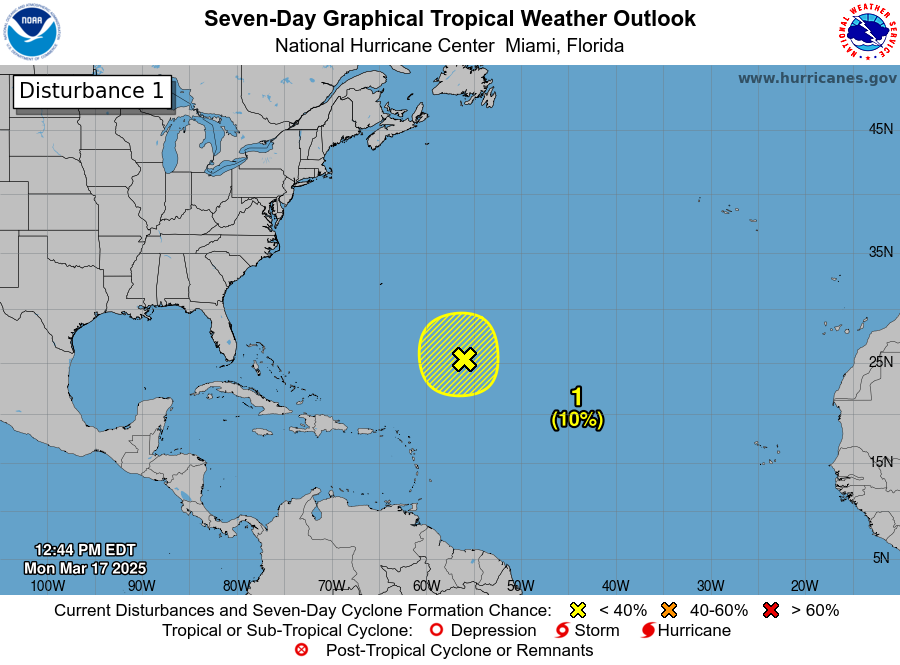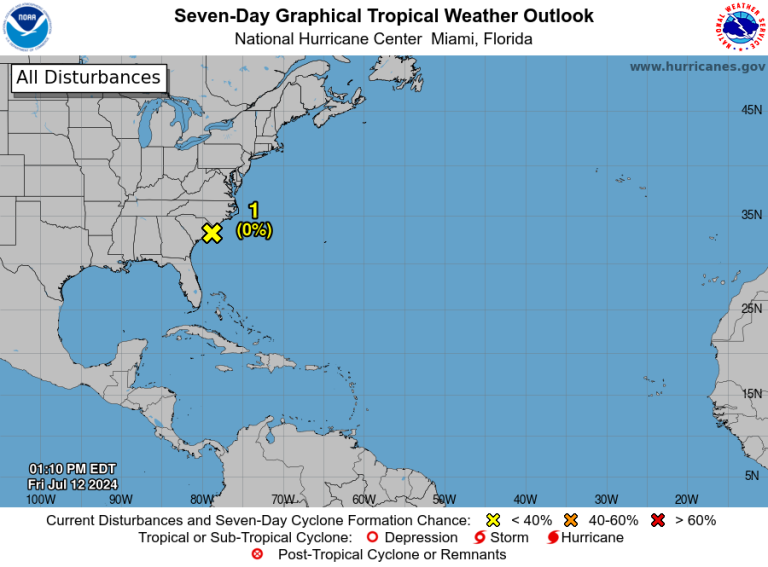A low-pressure system off the southeastern coast of the United States should move completely inland this afternoon, according to the latest report from the National Hurricane Center.
Upper-level winds have prevented the system from developing into a tropical cyclone, but heavy rain and possible flash flooding are possible over parts of the Carolinas and mid-Atlantic tonight.
Flood watches are in effect from South Carolina to Massachusetts.
➤ Track all active storms
Rainfall associated with beryl remnants is bringing locally heavy rain to upstate New York and northern New England into Thursday night, AccuWeather said. Up to 8 inches of rain fell in some areas.
Now, new tropical moisture along the Atlantic Coast will bring additional rainfall, especially along much of the Interstate 95 corridor today and into the weekend. Forecasters said localized rainfall amounts of 6 to 8 inches could occur in 24 hours or less.
Elsewhere in the tropics, the National Hurricane Center is monitoring five tropical waves, two of which are in the Caribbean.
Tropics should remain quiet until late July, but 'don't let your guard down'
AccuWeather forecasters predict the tropics will remain quiet until the end of the month due to Saharan dust and strong wind shear in the Atlantic basin. Both will reduce the risk of the storm developing or intensifying.
“We're in the doldrums of the season,” AccuWeather chief hurricane expert Alex DaSilva said. “The possibility is always there, but we don't see (another Beryl) happening.”
Things may improve by the end of July or early August.
“We're still expecting a very, very busy season,” da Silva said. “Don't let your guard down. Don't be fooled by the lull. We're in the early days of hurricane season. Hurricanes are going to intensify, and likely to intensify very quickly.”
The next storm this season will be Debbie.
Here are the latest updates from the NHC as of 2 p.m. July 12:
What is NOAA tracking for the Atlantic Basin?

Low pressure system along the coast of North Carolina and South Carolina: A large area of low pressure centered near the South Carolina and North Carolina coastlines continues to produce unorganized showers and thunderstorms.
Strong upper winds should limit any development of this system before it moves completely inland this afternoon.
However, this disturbance will likely result in heavy rainfall tonight along the Carolina and Mid-Atlantic coasts, with the potential for flash flooding.
- Chance of formation within 48 hours: Low, close to 0%.
- Chance of formation within 7 days: Low, close to 0%.
Elsewhere in the tropics, the National Hurricane Center is monitoring:
Tropical Wave 1: Tropical waves in the eastern Atlantic Ocean are moving westward at 11 to 17 miles per hour.
Tropical Wave 2: Another tropical wave in the eastern Atlantic Ocean is moving westward at 11-17 mph.
Tropical Wave 3: Tropical waves in the mid-Atlantic are moving westward at 17 miles per hour.
Tropical Wave 4: Tropical waves in the eastern Caribbean Sea are moving westward at 23 mph.
Tropical Wave 5: Tropical waves in the western Caribbean Sea are moving westward at 11 miles per hour.
Who might be affected?

Low pressure area near the Carolinas: Heavy rainfall will occur tonight along the Carolina and mid-Atlantic coasts, with possible flash flooding. Some areas could see 6-8 inches of rain in 24 hours.
Forecasters urge all residents to continue monitoring the tropics and stay prepared. This advice is especially important during what is expected to be a very active hurricane season.
Florida issues weather watches and warnings
When is the Atlantic hurricane season?
The Atlantic hurricane season lasts from June 1 to November 30.
When is the peak of hurricane season?
The peak of the season is September 10, with the most activity from mid-August to mid-October, according to the Hurricane Center.
National Hurricane Center Map: What are forecasters looking at now?
Systems currently being monitored by the National Hurricane Center include:

Interactive map: hurricanes, tropical storms passing near your city
Too much rainfall expected
What's next?
We will continue to update our tropical weather forecast reports daily. Download the local website's app to make sure you're always in the loop with the news. And find our special subscription offers here.
